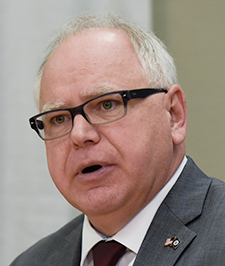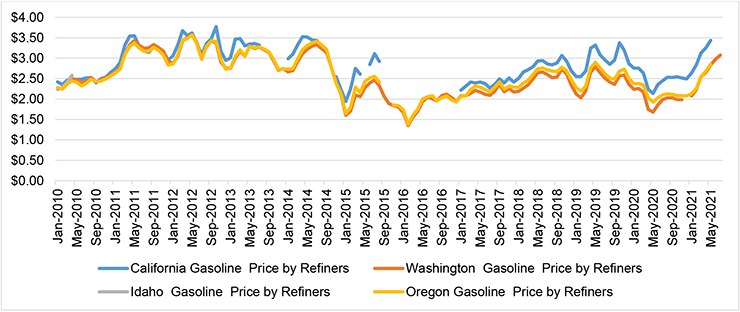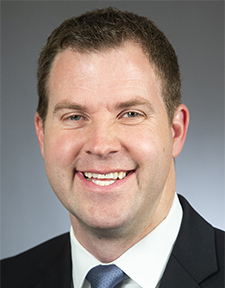The proposal for what’s known as a low-carbon fuel standard has become one of Democrats’ key plans for reducing carbon emissions in Minnesota’s transportation sector, the state’s largest source of climate pollution.
The policy would require fuel suppliers to make their product cleaner over time, and — unlike other major climate change plans backed by DFLers — has drawn interest from some Republicans and agriculture industry groups.
But, as prices have risen at the pump, so too has GOP opposition. Republicans have argued the proposal would cause gas prices to rise, though by just how much and when is a topic of debate.
“Once again Gov. Walz is trying to bring California-style regulations to Minnesota and drive up costs for families at a time when they’re already struggling with inflation at 40 year highs, $4/gallon gas, and soaring home energy prices,” said Waseca Rep. John Petersburg, who is the top Republican on the House’s Transportation Committee, in a statement.
What the low-carbon fuel standard does
The latest version of the proposal in Minnesota, sponsored in the House by Rep. Todd Lippert, DFL-Northfield, requires the “carbon intensity” of fuel supplied to Minnesota to be at least 25 percent below a 2018 baseline by 2030, 75 percent below baseline by 2040 and 100 percent below that baseline by 2050.
The intensity measure is a score assigned to each supplier that takes into account the “lifecycle” greenhouse gas emissions of producing, transporting and using the fuel. In addition to accounting for fuel emissions coming out of a tailpipe, for instance, it also counts coal or natural gas used to generate electricity for electric vehicles, as well as the energy used to produce crops for biofuels.
Under the policy, the state would set up a complex system of credits and deficits for fuel suppliers to trade. A supplier would earn credits when they meet state pollution benchmarks, but those who fail to reduce their carbon intensity enough would need to buy credits to make up their deficit. The money could then pay for efforts to advance cleaner fuels. The state Department of Transportation estimates a low-carbon fuel standard could slash transportation emissions by 50 percent or more by 2050.

A version of the low-carbon fuel standard has been adopted in California, Oregon and Washington. California was the first state to enact the regulations in 2011, though Oregon started one in 2016. Washington state lawmakers passed a fuel standard last year, though state officials are still working to implement the program.
In Minnesota, the program has drawn interest from at least some Republicans, mainly because it could benefit the ethanol and biodiesel industry. The California program has been a boon for biofuels; last year, the American Coalition for Ethanol said demand for E85 had quadrupled since 2011, and the organization endorsed a version of the policy in Minnesota.

Gas prices raise more concerns
Last year, House Republicans questioned if gas prices would increase as a result of the low-carbon fuel program, but at the time the GOP legislators also had other worries, such as whether advancing biofuels and EVs would be a problem for constituents who like to drive older cars or recreational vehicles like four wheelers and snowmobiles.
This year, House Republicans have more forcefully rejected the low-carbon fuel plan because of the potential hit to gas prices, which are already high in Minnesota and the U.S.
The GOP is not alone in its concern. In a March 29 letter, the Minnesota Chamber of Commerce said that “based on the experience of other states, a low-carbon fuel standard would likely further increase the cost of gasoline by a more than nominal amount at a time when Minnesota consumers can least afford it.”
Even the Minnesota Corn Growers Association and Minnesota Soybean Growers Association — which benefit greatly from biofuels — sent a letter to House Democrats with concerns about gas prices, arguing it would be better to have a regional approach with the entire midwest involved rather than Minnesota alone adopting low-carbon fuel regulations.
What other states say about their programs
House Republicans and others who are opposed point to a 2021 analysis from the California-based consulting group Stillwater Associates, which assesses the fuel market. The group says California’s fuel standard added about 22 cents per gallon of costs to gasoline in 2020.
Officials in California have somewhat lower estimates, though the numbers do rise over time as the regulations require cleaner fuels. State officials told the Washington news outlet Crosscut in 2019 that gas prices could have risen by a maximum of 8.9 cents per gallon because of the fuel standard in the program’s eight year. That’s when fuels had to be 5 percent cleaner compared to a 2010 baseline.

Either way, Minnesota officials and supporters of a low-carbon fuel standard here have looked mainly to Oregon in researching and developing a proposal, since that state’s economy is more analogous to Minnesota’s than California’s is, they say.
Oregon officials estimated that in its first year of measuring gas price impact in 2017, using a formula based on the price of the fuel standard credits, the cost of the initiative per each gallon of E10 was hardly anything — less than a third of one cent. But that cost has ramped up over time as the state’s regulations have gotten tougher, requiring cleaner fuels. In 2020, it was 3.71 cents per gallon for E10 and last year it was 5.09 cents per gallon.
For context, some Minnesota House DFLers, who are also concerned with high gas prices, have proposed the state stop collecting a 28.5-cent per gallon tax from Memorial Day to Labor Day to help people shoulder the surge in gas prices.
This Oregon estimate comes with some caveats, however. Officials there say the formula likely overstates the price of the program because it assumes fuel suppliers will buy all the credits they need to comply, which is the most expensive way to adhere to the program. A report published Feb. 1 by Oregon’s Department of Environmental Quality says many companies also generate credits themselves, which means they’re meeting the low-carbon fuel standards. Some fuel suppliers have long-term contracts with low-carbon fuel producers where they exchange credits and fuel at below-market value.
And companies can also use the value of the credits to decrease the cost of low-carbon biofuels or make other energy like electricity cheaper for customers. (California officials told Crosscut they had similar caveats with their estimates.)
The Oregon DEQ says prices for low-carbon fuels have decreased. Retail prices for gasoline and diesel are also within the range of neighboring states, the report says, including ones without low-carbon fuel standards like Idaho.
If a low-carbon fuel standard does raise gas prices significantly in Minnesota, it’s not likely to be in the near future. If the Legislature adopted new regulations this year, it would take time to implement them and for the impact on gas prices to rise as the standards get tougher.
Supporters have also pointed to a different analysis from Bates White Economic Consulting that the primary driver of fuel price in California is the cost of crude oil.
Still, there are still many questions about gas prices and the fuel standard. MNDOT held more than 30 meetings in the last year to hear feedback on a potential low-carbon fuel standard, which is also a sign of the Walz administration’s interest in the proposal. The agency said in a March report that there is a “strong desire” for a better understanding of how a low-carbon fuel standard would impact fuel prices.
Uncertain path forward in Minnesota
State Rep. Jamie Long, a Minneapolis DFLer who chairs the House’s Climate and Energy Finance and Policy Committee, said he felt the fuel standard wouldn’t have a significant impact on gas prices, and said Minnesota could have have “off ramps,” meant to change or suspend the policy if prices rise above a certain level.

Long said he tried to get Senate support for the measure last year when an earlier version of the bill passed the House, and wasn’t successful. He said he wasn’t sure much would change this year and is trying to focus on areas where the DFL might find compromise with Republicans.
Long’s counterpart in the Senate is Sen. David Senjem, R-Rochester, who chairs the Energy and Utilities Finance and Policy Committee. Senjem actually sponsored the fuel standards bill in 2021, and said Monday it could be a worthwhile clean energy policy in part because it’s a path to decarbonizing the state — and because it aids biofuels.

Still, Senjem said he thinks the idea is “noble,” and not “done done done.” He said he plans to have a meeting on the legislation with GOP senators and dive into it deeper. A public hearing this year is unlikely, but he said the bill could be a pathway “towards energy independence.”


0 Commentaires